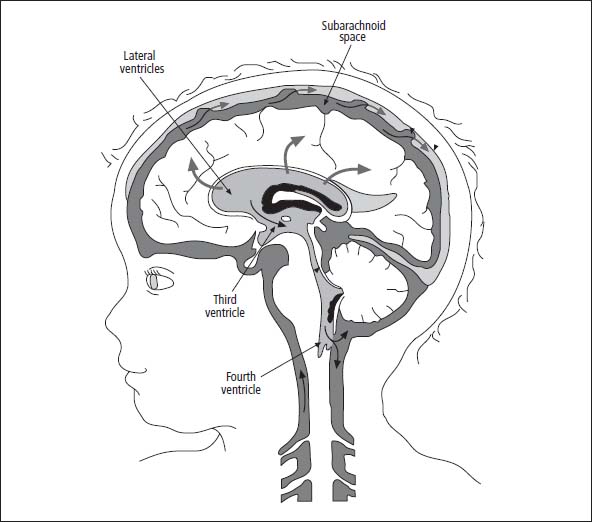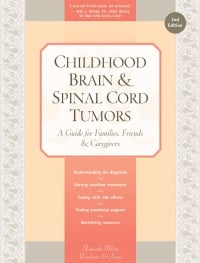Childhood Brain and Spinal Cord Tumors
Ventricular system
The ventricular system, shown in Figure 2–6, is made up of four fluid-filled chambers in the brain, called ventricles. These areas in the brain circulate CSF that bathes the brain and spinal cord. Under normal conditions, the brain produces approximately 1 pint of CSF a day. Healthy bodies absorb the amount produced each day. Disruptions in the balance between the amount of CSF produced and reabsorbed can result in too much CSF, which increases the pressure in the brain. This fluid buildup, called hydrocephalus, occurs in two ways:
- A tumor grows in or pushes into a ventricle, blocking the normal flow of CSF
- Blood, tumor cells, a scar, or dead tissue obstructs the subarachnoid space and prevents the absorption of CSF

Figure 2–6: The ventricular system
My son Paul had multiple admissions for pneumonia and a collapsed lung as a baby. The doctors were sure he had cystic fibrosis. After many tests, they decided maybe they were wrong. Summer started and everything was going well. In August he again started getting sick. Over the next 2 months, Paul’s balance deteriorated. By October he could no longer walk. Our family doctor sent us to see a neurologist. On the day of our appointment, we went to the neurologist and were told we didn’t have an appointment, that we would have to reschedule. The nurse had forgotten to write us in the book. I insisted we be seen and we sat in the office until the doctor saw us. The doctor thought Paul might have muscular dystrophy. She wanted to do a baseline MRI. We took the films back to her office to view after the MRI. She told us Paul had hydrocephalus. She was showing us the films and explaining, when she said, “Oh my God, he has a tumor. I’m so sorry.” They started preparing to admit him to pediatric intensive care unit. His hydrocephalus was life-threatening and he was in surgery 3 hours later to place a VP shunt. Paul had his tumor completely removed; he was 21 months old. His tumor was in the posterior fossa and was determined to be an ependymoma.
Table of symptoms based on tumor location
The table below summarizes the symptoms associated with tumors in various parts of the brain.
| Part of the Brain | Symptoms |
| Frontal lobes | • Seizures • Changes in ability to concentrate • Poor school performance • Changes in social behaviors and personality |
| Temporal lobes | • Partial complex seizures (staring spells) • Behavior problems (aggressive, impulsive) |
| Parietal lobes | • Seizures often involving shaking of an arm or leg on the side that is opposite of the tumor • Difficulty processing information • Language and memory problems • Weakness of arm or leg on side opposite of tumor |
| Occipital lobes | • Loss of central or peripheral vision |
| Cerebellum | • Problems with balance • Uncoordinated gait • Difficulty judging distances |
| Brainstem | • Abnormal eye movements or a droopy eyelid • Drooping of the face or facial asymmetry • Difficulty swallowing or breathing • An uneven walking pattern • Weakness on one or both sides of the body, often seen first in an arm and/or a leg |
| Diencephalon | • Disruption of hormone production • Abnormal growth • Excessive thirst and frequent urination • Drowsiness • Difficulty with vision • Memory problems • Weakness of one or both sides of the body |
| Optic nerves | • Visual changes (loss of peripheral vision, decrease in visual acuity) |
| Spinal cord | • Back or leg pain that awakens the child from sleep • Curvature of the spine • Weakness in arms or legs • Changes in sensation (tingling, numbness) in the back, arms, or legs • Changes in bowel and bladder function |
| Ventricular system | • Hydrocephalus • Lethargy • Headache • Vomiting |
Table of Contents
All Guides- Introduction
- 1. Diagnosis
- 2. The Brain and Spinal Cord
- 3. Types of Tumors
- 4. Telling Your Child and Others
- 5. Choosing a Treatment
- 6. Coping with Procedures
- 7. Forming a Partnership with the Treatment Team
- 8. Hospitalization
- 9. Venous Catheters
- 10. Surgery
- 11. Chemotherapy
- 12. Common Side Effects of Chemotherapy
- 13. Radiation Therapy
- 14. Peripheral Blood Stem Cell Transplantation
- 15. Siblings
- 16. Family and Friends
- 17. Communication and Behavior
- 18. School
- 19. Sources of Support
- 20. Nutrition
- 21. Medical and Financial Record-keeping
- 22. End of Treatment and Beyond
- 23. Recurrence
- 24. Death and Bereavement
- 25. Looking Forward
- Appendix A. Blood Tests and What They Mean
- Appendix C. Books and Websites

